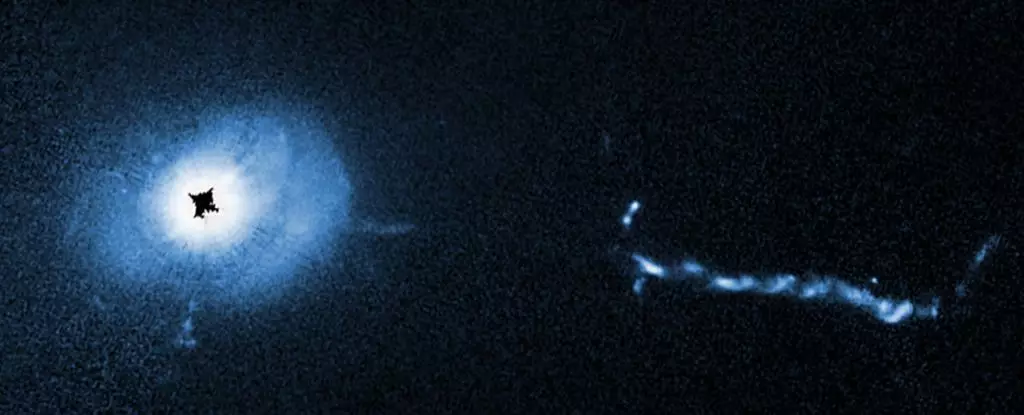Quasars represent one of the universe’s most dazzling mysteries, captivating astronomers and enthusiasts alike with their overwhelming luminosity and enigmatic nature. Positioned as the driving force behind these celestial phenomena are supermassive black holes situated at the heart of galaxies, which inadvertently fuel the brilliance observed in quasars. Unlike fleeting cosmic events like gamma-ray bursts or supernovae, quasars maintain a lasting presence in the cosmic canvas, allowing the scientific community to probe deeper into their complexities. The latest observations of the quasar 3C 273, located approximately 2.5 billion light-years from Earth, have unveiled unprecedented details that enhance our understanding of these astronomical beasts.
As our closest quasar from a luminosity standpoint, 3C 273 shines with the combined light of trillions of suns, presenting an extraordinary opportunity for detailed study. Despite its distance, the sheer brightness makes it visible with relatively modest telescopes, offering an enticing glimpse into the vast cosmic expanse. This accessibility has made 3C 273 a prime candidate for extensive analysis, enabling astronomers to explore the intricate dynamics at play within quasar systems.
The recent revelations surrounding 3C 273 stem from advanced observations conducted through the Hubble Space Telescope, particularly using the Space Telescope Imaging System (STIS). This technology allowed astronomers to construct a makeshift coronagraph, a device that effectively blocked out the overwhelming light emitted by the quasar itself. This innovative approach can be likened to shielding one’s eyes from a bright flashlight; by doing so, researchers could capture the faint structures surrounding the quasar, leading to groundbreaking findings that were previously elusive.
The latest observations have revealed details that are a staggering eight times closer than prior measurements, highlighting small clumps of material that could represent satellite galaxies or remnants being absorbed by the quasar’s immense gravitational pull. Additionally, researchers observed new core jets and an enigmatic L-shaped filament, the nature of which continues to baffle scientists. These insights are just the beginning, as they pave the way for deeper explorations into the cosmic ballet where quasars operate.
In their quest to understand quasar behavior, astronomers have begun to analyze the physical jets emitted from black holes. The recent Hubble observations also uncovered detailed measurements of a jet extending into intergalactic space, reaching an astonishing length of 300,000 light-years. Interestingly, this research indicates that the speed of the jet varies, with its velocity increasing the farther it travels from the black hole’s gravitational influence. This revelation presents several intriguing questions about the dynamics governing quasar behavior and how material is expelled into the surrounding void.
The interplay between black holes and their jets highlights the complexity of galactic interactions and the processes at work in quasar environments. As researchers collaborate to decode the motion and structure of these astrophysical jets, they are essentially piecing together a cosmic narrative that details not only the life cycle of a quasar but also its evolutionary relationships with neighboring galaxies.
The analysis facilitated by the Hubble Space Telescope serves as a significant advancement in our understanding of quasars, bridging the gap between different observational techniques. The intricate spatial structures and dynamic jets observed in 3C 273 offer a more nuanced view of quasar morphology than has been previously documented. As astrophysicist Bin Ren remarked, these observations enable scientists to extend their investigations and provide insight into the broader behavioral tendencies of quasars.
As the research community continues to study 3C 273 and other quasars, the implications stretch far beyond this individual object. Each discovery contributes to the evolving landscape of astrophysics, reshaping our understanding of supermassive black holes, their feeding habits, and their influence on the formation of galaxies. This exploration opens the door for future inquiries into other luminous astronomical phenomena, each step laying the groundwork for a more profound comprehension of the universe’s mysteries.
The recent observations of the quasar 3C 273 underscore the important role that cutting-edge technology, like the Hubble Space Telescope, plays in advancing our cosmic knowledge. With newfound details and insights, astronomers are well-equipped to tackle the complexities surrounding quasars, challenging previously held theories and exploring new avenues of research. As we stand on the cusp of further discoveries, the cosmos continues to beckon humankind, revealing its secrets to those willing to explore the depths of the universe. Each new observation not only enhances our understanding but invites a wave of curiosity about what lies beyond, fueling an eternal quest for knowledge in the infinite expanse of space.

